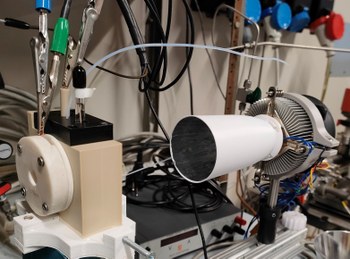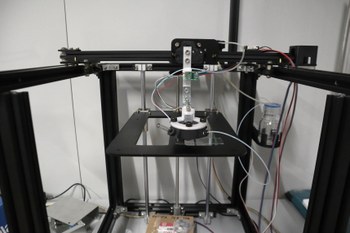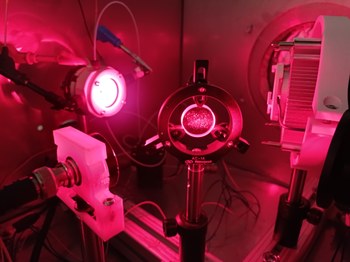Optoelectronic characterization

Photoelectrochemical (PEC) characterization station
Integrated PEC Setup, equipped with:
- AM 1.5G Class ABB solar simulator
- High power white LED, up to 3-sun equivalent with tunable irradiance
- Gamry Interface 1010T potentiostat
- Inert atmosphere inlet
- Custom Photoelectrochemical cells
- Micro Gas Chromatography for gaseous products characterization

Scanning Photoelectrochemical Flow Cell (SPFC)
A Scanning Photoelectrochemical Flow Cell (SPFC) is an experimental arrengement designed to investigate photo-electrochemical properties of the working electrode with spatial resolution, at milli- or microscale, while maintaining a continuous flow of electrolyte solution. Tipical target samples come from combinatorial synthesis, where one or more parameters, such as thickness, commposition or doping, are made to vary continuously along some direction of the sample, enabling researchers to populate material libraries with properties of particular interest. In addition, the possibility to authomatize measurements procedures in different sample sites open the way to collect large amount of data in a relative short time with respect to the standard one-by-one sample characterization.
The SPFC is equipped with several key components that work in harmony to create a controlled environment for photoelectrochemical investigations. These components include:
- Scanning System: The term "scanning" in SPFC refers to the ability of moving the PEC cell along diffrent direction of the working electrode. This is achieved by mounting the cell on a motorized XYZ stage that can be remotly controlled and synchronized with the data acquistion setup. This movement allows to map the electrochemical activity across a surface or to probe specific areas of interest systematically.
- Flow System: The flow system ensures a steady and controlled flow of electrolyte solution over the sample site under investigation. This flow serves multiple purposes, such as maintaining a fresh electrolyte supply, removing reaction byproducts, and providing a consistent mass transport environment.
- Photo-electrochemical Cell Housing: The electrochemical environment is enclosed in a well-designed cell housing that allows to control and maintain the experimental conditions. This housing ensure the minimization of the cell resistance by accomodating counter and reference electrode as close as possible to the working electrode. In addition, a quartz window placed on top of the cell allows the illumination of the working electrode with different light sources.
- Data Acquisition and Analysis: SPFC setups are typically equipped with data acquisition systems, usually a potentiostat, to record current-potential curves and other relevant electrochemical data. Advanced analysis techniques are then applied to interpret the obtained data and gain insights into the electrochemical processes occurring at the milli/microscale.
Applications of a SPFC are diverse and span various fields, including materials science, corrosion research, catalysis studies, sensor development, and fundamental electrochemical investigations. The setup's ability to combine flow control with spatial resolution makes it a powerful tool for characterizing and manipulating electrochemical reactions on a small scale, contributing to the advancement of both scientific knowledge and technological innovation.

IMPS Setup
Intensity modulated photocurrent spectroscopy (IMPS) is a small-perturbation optoelectronic technique that measures the quantum efficiency of a photoelectrochemical device as a function of optical excitation frequency. IMPS relies on measuring the response of a device to a small AC perturbation while biased at some DC level typical of its operation, e.g. water oxidation potential, providing information on the charge carriers dynamics in the us to s time regime. The experimental apparatus consists in:
- Potentiostat with FRA module up to 1MHz.
- Flow PEC cell with integrated peristaltic pump.
- Monochromatic LED source coupled with LED driver, integrated with external DC+AC signal generation for light intensity modulation.
- 1 sun equivalent white LED as bias light source
- Optical bench with beamsplitter and photodiode for light impulse detection
A custom in-house python-based analysis algorithm is available to extract relevant information from IMPS analysis.(gDRT-Lasso algorithm).
UV/Vis/NIR Spectrophotometer
The Cary 5000 UV-Vis-NIR spectrophotometer is a high-performance UV-Vis and NIR spectrophotometer with superb photometric performance in the 175–3300 nm range. The latest generation of PbSmart detector has improved its sensitivity and lowered stray-light in the NIR, making it a powerful tool for materials science research. The Cary WinUV software, a modular Windows-based software, makes it easy to perform powerful analysis and control a number of optional accessories.
Accessories Includes:
- External Diffuse Reflectance accessory coated with Spectralon, suitable for reflectance/transmittance measurements until 2500 nm.
- Small spot adapters
- Specular multi-angle acessory
- Cuvette holder
- Holder for solid samples/spectroelectrochemistry